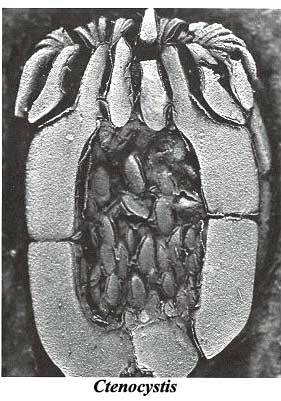Ctenocystoidea
 Ctenocystoidea are a small class of bilaterally symmetrical stem echinoderms from the Middle Cambrian of western North America and Bohemia, first described in 1969. Dominguez-Alonso 1999); Parsley 1999). An undescribed form from the Upper Ordovician of Wales has also been assigned to the Ctenocystoidea, but preliminary illustrations (Dominguz-Alonso, 1999) are significantly different from other members of the class, so we'll have to wait for a detailed description before passing judgment.
Ctenocystoidea are a small class of bilaterally symmetrical stem echinoderms from the Middle Cambrian of western North America and Bohemia, first described in 1969. Dominguez-Alonso 1999); Parsley 1999). An undescribed form from the Upper Ordovician of Wales has also been assigned to the Ctenocystoidea, but preliminary illustrations (Dominguz-Alonso, 1999) are significantly different from other members of the class, so we'll have to wait for a detailed description before passing judgment.
Ctenocystoidea differ from the more basal homalozoans in lacking an appendage. They are distinctly flattened and rectangular to trapezoidal in dorsal view. Like Cincta, they have a central covering of small tesselated plates with a row of much larger marginal plates around the outside edge of the theca.
 The most distinctive feature of the Ctenocystoidea (and the source of their name) is the ctenoid organ along the anterior margin. This is composed of two series (one each side of the mouth) of ctenoid ("comb-like") plates separated by paired rostral plates on the anterior mid-line. The ctenoid plates were dorsally articulated and so capable of slight movement. A space behind the ctenoid organ held the ambulacra. Dominguez-Alonso (1999) suggested that the ctenoid plates were covered in life by ciliary epithelium so the ctenoid organ acted as a ciliary pump drawing water into the ambulacrum.
The most distinctive feature of the Ctenocystoidea (and the source of their name) is the ctenoid organ along the anterior margin. This is composed of two series (one each side of the mouth) of ctenoid ("comb-like") plates separated by paired rostral plates on the anterior mid-line. The ctenoid plates were dorsally articulated and so capable of slight movement. A space behind the ctenoid organ held the ambulacra. Dominguez-Alonso (1999) suggested that the ctenoid plates were covered in life by ciliary epithelium so the ctenoid organ acted as a ciliary pump drawing water into the ambulacrum.
The hydropore is located at the anterior right of the dorsal integument, while the pyramidal anus is located at the centre of the posterior margin. The mechanism by which ctenocystoids moved is problematical. Parsley 1999) suggested that the ctenoid plates may have been mobile enough to claw the animal forward. Rather more dramatically, it has been suggested that water may have been forcibly expelled through the anus, moving the animal by jet propulsion. Dominguez-Alonso (1999). The potential here for comedic commentary being obvious, we leave it to the reader's own interpretation.
Placing the Cincta and Ctenocystoidea in the deuterostome phylogeny requires us to identify how the bilateral ambulacra of these classes correspond to the pentaradial ambulacra of crown echinoderms. Echinoderm ambulacra are identified by letters A-E, with A the anterior anbulacrum and the letters rising clockwise. In crown echinoderms, the ambulacra all run direct to the mouth, but in some pentameral stem echinoderms such as the edrioasteroid Stromatocystites, the B and C ambulacra fuse a short distance distally from the mouth, as do the D and E ammbulacra, forming the 2-1-2 ambulacral pattern. Jefferies 1997). In Cincta and Ctenocystoidea, the left is therefore probably the DE ambulacrum while the right is the BC ambulacrum. Dominguez-Alonso 1999) placed the Ctenocystoidea crownward of the the Cincta due to the loss of the posterior appendage and the greater symmetry of the ambulacra. We're willing to run with this hypothesis for now, but would like to point out that these are characters that could have easily appeared convergently.
© Christopher Taylor CT050908.
Images: Ctenocystis line drawing from Campbell 1987). Photo from FossilsForSale.com ONLINE CATALOG.
page uploaded ATW050908
 Ctenocystoidea are a small class of bilaterally symmetrical stem echinoderms from the Middle Cambrian of western North America and Bohemia, first described in 1969. Dominguez-Alonso 1999); Parsley 1999). An undescribed form from the Upper Ordovician of Wales has also been assigned to the Ctenocystoidea, but preliminary illustrations (Dominguz-Alonso, 1999) are significantly different from other members of the class, so we'll have to wait for a detailed description before passing judgment.
Ctenocystoidea are a small class of bilaterally symmetrical stem echinoderms from the Middle Cambrian of western North America and Bohemia, first described in 1969. Dominguez-Alonso 1999); Parsley 1999). An undescribed form from the Upper Ordovician of Wales has also been assigned to the Ctenocystoidea, but preliminary illustrations (Dominguz-Alonso, 1999) are significantly different from other members of the class, so we'll have to wait for a detailed description before passing judgment.